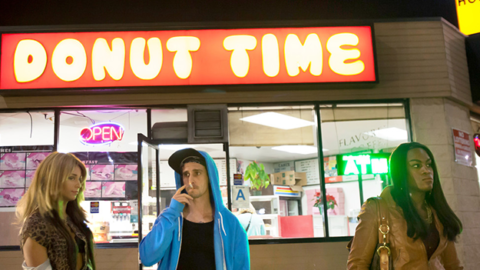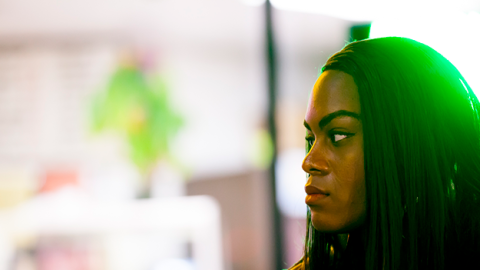Interview: Sean Baker
Sean Baker follows his 2015 breakout feature Tangerine with another high-energy movie about people whose imaginations are undaunted by living on the margins. In The Florida Project, six-year-old Moonee (remarkably expressive Brooklynn Prince) and her two best friends spend the summer running wild on the grounds of the Magic Castle, a week-by-week motel just a mile away from Florida’s Disney World. For these children, overgrown weeds, deserted houses, and nearby posh hotels spell adventure, and seen through their eyes and the lenses of Alexis Zabe’s 35mm camera, theirs is a lushly tropical, dazzlingly colorful world. But for Moonee’s mother, Halley (Bria Vinaite, fierce and vulnerable), play is less of an option. Halley’s inventiveness is directed toward bringing in enough money to pay the rent every seven days and cajoling the motel manager (Willem Dafoe, modest and solid) into turning a blind eye when she breaks the rules. In the ingenious narrative structure devised by Baker and cowriter Chris Bergoch, Halley’s struggles are the subtext to Moonee’s rhapsodic explorations, until the moment when things fall apart. This interview took place at the 2017 Cannes Film Festival. The Florida Project screens at the New York Film Festival on October 1 and 3.
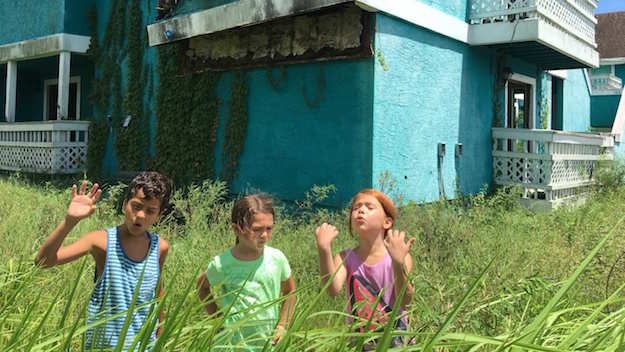
Where did you grow up?
New Jersey. I moved to New York when I went to Tisch at NYU. I made two features in New York, Take Out [2004], released by Kino, and Prince of Broadway [2008]. In 2012, I went to L.A. to make Starlet and stayed there to make Tangerine [2015] with the same co-screenwriter for both, Chris Bergoch. He brought me the topic for The Florida Project.
Had you ever lived in Florida?
No. Chris’s mother lives in Orlando, and he loves Disney World.
Just as in Tangerine, there’s an incredible sense of place in this movie.
For me, a place becomes a character. In Florida, we had many motels to choose from. All up and down Rte. 92 there are budget motels that are now being inhabited week-to-week by families. But it was the Magic Castle that I wanted so badly, because of the connection, and because of the color. I didn’t paint it purple; it was already purple.
And where did you cast the kids.
I always do street casting. It’s important to me. I found Valeria Cotto, who plays Jancey, at a Target. I noticed her at a distance because of her striking red hair. I gave her mother my card. At first she was taken aback, but she Googled me and saw I was legit and brought Valeria in to audition. Christopher [Rivera] came in through a casting call. We cast a very wide net. He came in with such energy and won us over in seconds. We later found out that he is actually a motel kid, and I’m happy that the film could make his family a bit of money, and maybe give him a start, if he wants act. I mean, they are so young, who knows where they are going to go, but I would love to see the industry embrace all my actors. And of course, there’s Brooklynn Prince, who plays Moonee. She’d already been acting for a while, in Dolphin’s Tale 2 and in commercials. When she came in, I knew immediately that she was the one for this role. I don’t know what people think about my film, but she will be a star. She’s one of the best actors of any age I’ve ever worked with or come across. My whole goal with these characters was to find the modern-day Spanky McFarland from Little Rascals, and I really feel I found her in Brooklynn. And her parents are well grounded, they let Brooklynn make up her mind about everything. She’s intelligent, she’s enthusiastic, she’s always in a good mood, she never wanted to go home at the end of the day. And when she delivered the goods in terms of the drama, we weren’t expecting that she could take it to that level. I remember looking at my acting coach and cinematographer, and we were all teary-eyed. We were shooting in 35mm, so we had to send the film to Atlanta to get processed and to New York to get scanned. I was so nervous. But when I called New York, they said you have 50-year-old guys in the transfer room crying.
We wanted to hire someone with a name to play Halley, Moonee’s Mom, but I really didn’t want an actor that the audience already knew. With Willem [Dafoe], it’s easy. He’s so transformative. I’m so grateful to work with an actor of that caliber. Our colorist is from Florida, and he said, “That’s a Florida man, he captured it.” Willem came in a couple of weeks prior to production to meet the motel managers from Rte. 92 and he sat down and talked with one in particular about what it’s like to be a working-class person who has to deal with 200 families, some who can’t pay the rent, and yet he has to keep his job and keep his boss’s business from going under.
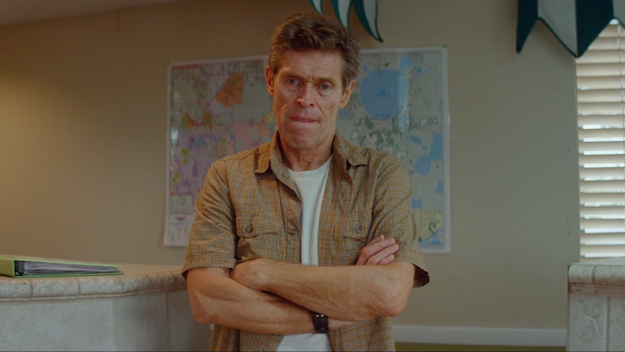
But let’s go back to casting Halley.
I found Bria Vinaite on Instagram. She had never acted, but there was something about those videos. She was such a firecracker. I saw she had street smarts. She made me laugh. And she had that physicality—those shoes and the hair. So I told my team that whatever A-list Hollywood actress we would get would need to transform into this. So instead, let’s reach out to Bria. We brought her down to Orlando to meet the kids and there was an instant bond. Brooklynn sat in her lap. I wanted that, for their relationship to have a sibling thing going. Halley is a child having a child. Bria’s acting just kept growing. By the time we did this long Steadicam shot—where she slaps that thing on the window—I knew I didn’t worry that I’d have to use editing to manipulate the performance. She completely held this five-minute take with Willem.
How long was the shoot?
Thirty-five days. I needed a lot more. You’re dealing with kids, with 35mm, and with summer in Orlando, which is sweltering heat.
And why, after shooting Tangerine on an iPhone, did you not just go for a higher standard of digital?
You can find beauty in digital, but there is something that film has that digital doesn’t. It’s that organic quality—something living and breathing in that celluloid and the way it captures the light and images on that silver. I’m still not convinced that digital can replicate that. I wanted the audience to be living in and feeling Orlando, and I thought that having this organic material would help that. Plus, I worked with Alexis Zabe, who shot Carlos Reygadas’s Silent Light. I wanted something on that level. And I wanted my images to be like photographs. I wanted every frame to work as an individual photograph, and using film was going to help us achieve that. And one last thing: I wish more filmmakers would shoot film. I look up to Paul Thomas Anderson and Christopher Nolan for staying with celluloid, because that’s what made this medium alive, and we are in danger of losing it. Just because a new cheaper format comes along, we don’t have to abandon the old one. Digital is great. It’s obviously what got me here. I shot a film on the iPhone and it got me a lot of attention, and I might do it again in the future. But when I had the means to shoot on film, I took the opportunity.
When I watched your movie at the press screening in Cannes, I loved it, but I worried that other people wouldn’t know what to make of it. There’s so little narrative structure that it almost seems like an experimental film. It just has the energy of these kids running wild and this impressionistic portrait of Moonie and Halley fighting for their existence. There isn’t a three-act structure or the usual character arcs.
There is a narrative, but it’s a little disguised or covered up. When I look at my own past work, I’m critical of it for having been too narrative heavy. For some reason, Hollywood—American cinema in general—finds it necessary to follow the three-act form, and if you don’t do that it means something’s wrong with your film. They say you need a clear three-act structure and heavy arcs for every character, and the audience needs to know what’s going on in the first 30 seconds. This is so closed-minded and not progressive. For this film I wanted the audience to feel like they’ve spent the summer with these characters. And when has your summer ever been plot-driven? No, you’re just meandering through your summer. I felt it had to be just a series of events, not bound to a plot.
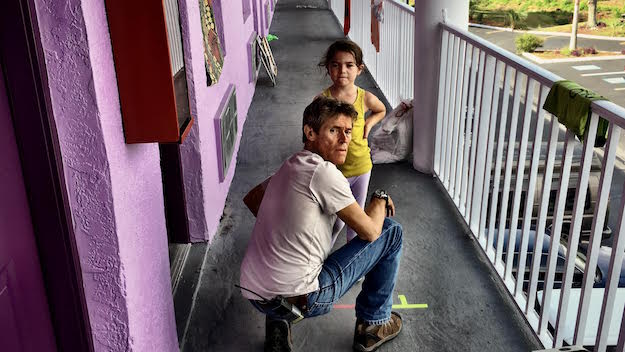
What is the situation of the people who live in these motels? I’m presuming that most of them are on welfare. They aren’t quite homeless.
The motels have become the last refuge before they are out on the street or in shelters. But technically they are homeless because they pay by the week so they don’t have a legal permanent residence. And because they might have bad credit or they’re working low wage jobs, they can’t get together money for a down payment on a permanent place. The situation originally stemmed from the recession and the housing crisis. You have children who’ve been born since then who have never known any other way of living. I was in Walmart a week out from shooting. We’d already written that 99-cent store scene with the child in the shopping cart and suddenly a woman who looked exactly like Halley was pushing her child around Walmart in a shopping cart and they were having the most fun that a mother and daughter could have. I gave them my card and we went out for coffee in a Dunkin’ Donuts. She told us her story. She had other children too. She told us about getting into the system. Her story for us—two writers and filmmakers from outside of that world—was the thing we needed so we could feel comfortable with what we were doing in terms of representation. We’d met the real Moonee and the real Halley.
You’ve also made two films in a row about people who are totally marginalized.
And the other two films before them as well. I’m very interested in learning more about the underground economy, where so many Americans are forced to turn. I think shining a light on that will eventually lead to change. Awareness leads to education, and education is the key to change. I also feel as if these films are a reaction to what I’m not seeing and what I want to see. Why are the same stories being told about the same people? I know this is a bit of a broken record right now—in terms of diversity. My girlfriend is an Asian woman who’s no longer 18. She’s been a working actor in Hollywood and she’s no longer getting cast because there are no roles written for anyone like her. I think audiences are interested in diversity, but Hollywood doesn’t believe that. Even if audiences don’t talk about this or even consciously know it, I think we long for the universal themes that connect us to different people. After Tangerine, I had a lot of people reaching out to me on social media saying “I never knew I’d want to hang out for two hours with two transgender sex workers in Los Angeles, and I not only had the time of my life, but also, what can I do to help?” In these crazy times, cinema can be entertainment, and it also can shine a light on issues and make us aware.
Amy Taubin is a contributing editor to Film Comment and Artforum.



